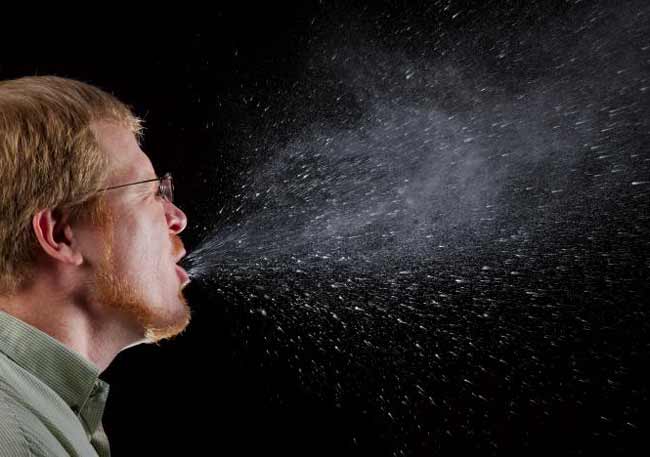The Science of Sneezing: Modeling Spray Exposure

The new swine flu's spread so far has left many wondering how best to avoid infection, and for good reason – modern medical experts still don't know how effectively the H1N1 flu viruses can travel from person to person.
Now researchers hope that new mathematical models can help answer whether the virus transmits best through direct inhalation exposure to sneezing or coughing, breathing smaller aerosolized droplets left in the air, or rubbing mucous membrane areas such as the eyes after touching contaminated surfaces. Just don't expect full answers immediately.
"We're not at the point where we can say what fraction of transmission you are going to prevent by wearing a mask, or what fraction you are going to prevent by washing your hands," said Jim Koopman, an epidemiologist at the University of Michigan.
Untested conventional wisdom
Half a century's worth of research has shown that diseases such as tuberculosis can effectively go airborne to infect people. Whether influenza viruses also possess a potent airborne attack remains more of a mystery, and could impact the success or failure of efforts to contain outbreaks such as the recent swine flu outbreak.
Many flu experts have said that getting sprayed by large droplets from a cough or sneeze is the most likely pathway for flu to spread, but with relatively little evidence to back it up.
"There's next to no quantitative experiments on what fraction would hit your eyes, nose and lips," said Mark Nicas, a public health researcher at the University of California-Berkeley. "Those are some of the current experiments I'm trying to get going here, hopefully."
Get the world’s most fascinating discoveries delivered straight to your inbox.
Similar uncertainly applies to the "three-foot rule" of keeping a certain distance from sick people, which is based on spray exposure experiments from the 1960s and 1970s.
"The three-foot rule makes sense physically, but it pertains to exposure by the droplet spray route and doesn't really apply to small particles that can spread through the air," Nicas told LiveScience.
Nicas started out focusing on airborne pathways for flu viruses, but also eventually saw how surfaces contaminated by droplets could serve as a third pathway. He noted "decent transfer efficiency" in the virus moving from surface to finger, then to eyes, nose or lips if a person unwittingly touches them.
Simplify, simplify
Here's the challenge behind modeling any of the pathways – trying to simplify reality enough to create a mathematical model, while keeping enough realism to squeeze useful answers out of the numbers.
Take those dirty hands as an example. A University of Michigan group, including Koopman, found that hand transmission differs greatly depending on the different types of potentially contaminated surfaces. Some surfaces might get touched by many different people, while others might be contaminated but have relatively little human contact.
The researchers then organized those surfaces into two or three categories depending on how they affected transmission, and voila – a simplified model that could still provide real-world insight.
Until recently, most disease models simply calculated the random mathematical chance that anyone in a certain city might get infected by diseases such as swine flu.
"The problem with those [previous] kinds of models is they really can't help us explore the role of different modes of transmission," Koopman explained. "In order to get down to the specific actions that anyone could take, we need to get down to thinking about transmission in different places."
Time and space matter because different pathways may become more important in certain situations. Koopman pointed out how airborne transmission might play less of a role in Japan, where people regularly wear masks out of courtesy when they are sick. That's just one example of the many differences in human behavior that a model would have to account for.
Tracking the behavior of everyone in just one small town can get expensive, and so researchers do the next best thing by collecting data on viruses in different environments and plugging that into their models.
"Once we have the right models, we can use that information more effectively," Koopman said.
No agreement on prevention
Unsurprisingly, different models produce different answers on what transmission pathways are most important for flu viruses. And that has led to some friction on recommending real-world action, even with the current swine flu outbreak.
"It's a little surprising to me that the government isn't suggesting face protection, because it helps for all three modes of transmission," said Lawrence Wein, a mathematical modeler at Stanford University.
Wein and Michael Atkinson, a Stanford colleague, caused a stir several years ago by creating a model of flu virus spread based on the characteristics of the common cold's rhinovirus. They concluded that airborne transmission through small, aerosolized droplets could represent a main pathway for influenza, and Wein wrote a 2006 New York Times op-ed arguing for widespread use of face masks.
Other researchers such as Nicas and Koopman remain skeptical of the Atkinson-Wein model's comparison of flu virus with rhinovirus.
"I think Atkinson and Wein sort of underestimated the ability of the hand-contact pathway to deliver a dose," Nicas suggested.
What everyone did agree was that modelers are still figuring out which real-world factors to focus on, and how to represent those factors mathematically. Koopman gave the example of trying to factor in dose response – a person might just get a low-level dose of flu virus with every breath, as opposed to touching a place where someone "slobbered a goober" with billions of flu viruses.
For now, Wein stood by his model and noted that the U.S. Department of Health and Human Services has begun looking into face protection guidelines. But he did give a nod to uncertainty.
"The prudent thing to do is really do both hand-washing and face masks," Wein said.
- Five Essential Swine Flu Survival Tips
- Top 10 Deadly Diseases That Hopped Species
- Is a Swine Flu Pandemic Imminent?



